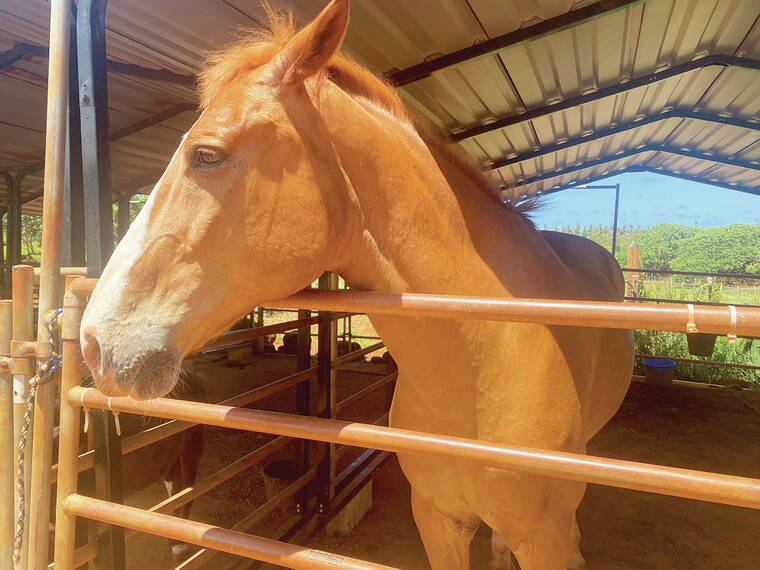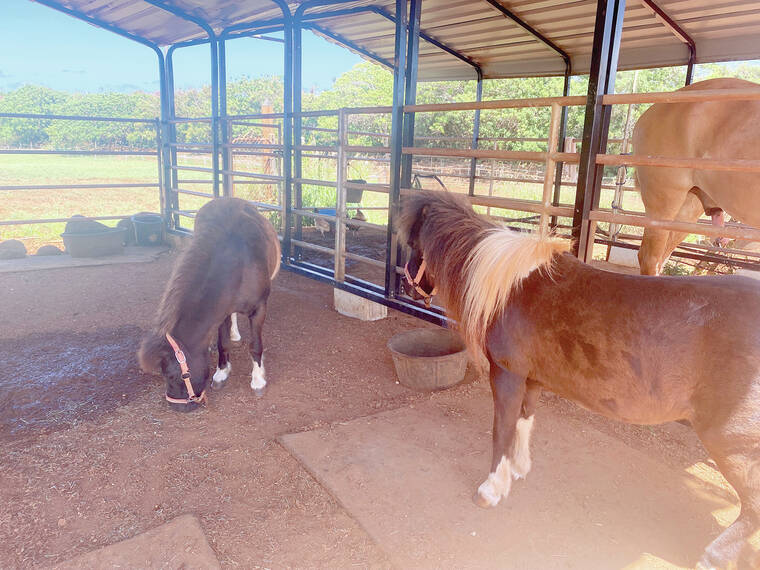WAIPOULI — Carriage horses Rowdy and Chip had a long journey before joining the Healing Horses stable on Kaua‘i.
The pair of 12-year-olds were bought in July last year and — after a cross country road trip from Florida to California, an airplane ride to O‘ahu, and a barge to Nawiliwili — finally arrived last August.
They didn’t clear COVID protocols (which are much stricter for horses) until October.
Soon Rowdy, the leader, and Chip, more of a follower, will help spearhead a new carriage-driving program that will allow the nonprofit to expand its services for those with severe disabilities.
“There’s a small demographic of persons on Kaua‘i who are not able to get on a horse, whether they’re wheelchair-bound or if they have some sort of medical device like an insulin pump,” said Healing Horses Executive Director Samantha Henriques. “There’s clients we can’t serve with the horses we have.”
The pair will join miniature horses Lollipop and Jellybean in the program, funded in part by a $31,005 county Office of Economic Development Innovation grant. It will provide those severely disabled clients with a chance to interact with horses as carriage drivers rather than riders.
Of the OED grant, $14,500 will go towards the purchase of a new carriage, while the remainder will be used to pay mainland instructors to conduct a workshop and complete the required mentorship training with Healing Horses staff. Henriques hopes that several staff members will be able to get certified by President’s Day 2023.
The horses themselves came through a partnership with the board and the Christopher Reeve Foundation.
Healing Horses holds between 50 and 75 lessons a week, with a focus on using the animals to improve physical and social-emotional wellness. Many of the clients they serve, 56% last year and closer to 70% in a normal year, have some sort of disability.
“I saw it work firsthand, and I’ve seen it work firsthand for dozens of kids,” said Henriques, who began working for the program in 2008 as a volunteer, and stepped into the executive director role in 2019.
According to Henriques, horses can pick up on 17 facial expressions and different tones of voice, which makes them good therapy animals.
“You have to learn how to control your body language around the horse. If you’re upset the horse will pick up on that and reflect that. It mirrors your emotions back at you.”
This communication still exists when a client is driving a carriage, said Henriques.
The carriage horses, larger and able to bear more weight than the rest of the Healing Horses stable, will be used both for carriage work and for traditional rides for larger riders. Both are show-trained, meaning that they can perform under pressure.
“They’re going to be bombproof,” said Henriques. “They can ride through cannon fire, gunfire — they did the Rose Bowl Parade.”
Healing Horses currently operates on a 150-foot-by-100-foot arena on land off the Kapa‘a bypass road leased from actress Bette Midler. But with the new carriage program they hope to expand.
The organization wants to add a 130-foot-by-260-foot secondary arena, the official size for carriage driving. Along with allowing for the driving program, the expansion will also allow them to serve dozens more clients.
For this to happen, the land needs to be cleared, a process that takes volunteer hours and additional funding.
Those wishing to donate or volunteer can visit healinghorseskauai.org/.
•••
Guthrie Scrimgeour, reporter, can be reached at 647-0329 or gscrimgeour@thegardenisland.com.









